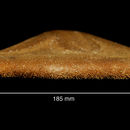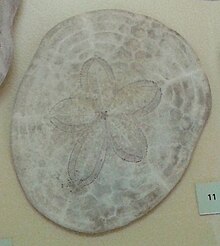en
names in breadcrumbs


Clypeasteroids are considered radially symmetrical. However, they show slight bilateral symmetry because they tend to be slightly elongated, an adaption to facilitate movement through sediment. The bony ossicles of this species fuse together, forming a calcareous, disk-shaped shell or test. The test is covered with short, movable, densely-distributed spines that aid in movement though sand while feeding. The aboral surface bears five conspicuous flower petal-like structures, called petalloids. These are actually the ambulacral grooves. Each petalliod is equal in size and consists of two double rows of paired pores used in respiration. Petalloids also contain tube feet that function in respiration. Unlike tube feet seen elsewhere, they lack suckers at the ends and do not function in locomotion (Fox 1994). Clypeaster subdepressus is large, up to 300 millimeters in length. The oral surface is quite flat, with a slight concavity at the mouth. The test color ranges yellow to dark tan (Hendler, et al 1995).
Other Physical Features: ectothermic
Clypeaster subdepressus lives in the sand fields or the shelly sediment in the warm waters of the Caribbean and Atlantic, where there is no or little grass (Hendler, et al 1995).
Aquatic Biomes: coastal
This species is found in the Caribbean Sea and along the Atlantic coast, ranging fron North Carolina to the east coast of central America to Rio de Janeiro, Brazil (Hendler, et al 1995).
Biogeographic Regions: nearctic (Native ); neotropical (Native )
Research has been done on the Aristotle's Lantern, specifically the dental ligaments (collogen strands that attach the teeth to the jaw) of these echinoderms, that periodically changes stiffness in different ionic concentrations. These ligaments are similar to the periodontal ligaments found in humans (Steinberg 1996).
Fossils of this echinoid have been reported from the late Tertiary deposites in Florida (Hendler, et al 1995).
The respiration of these animals is quite interesting. The respiratory podia are long low sheets that lie in the ambulacral groove (petalloid) extending from one pore to the other. Their long axes are parallel, and are close to, the surface of the test. The respiratory current generated by epidermal cilia flows over the surface of the podium from the center of the petalloid toward its periphery. The ciliated peritoneum of the water vascular system inside the podium moves a current in the opposite direction, from the periphery toward the center of the petalloid. Oxygen, following its gradient, moves into the podium from the sea water along the entire area of contact between tube food and sea water. Once inside the water vascular system, oxygen is then transferred to the fluid of the perivisceral coelom by another countercurrent mechanism, this one is between the water vascular system and the perivisceral coelom (Fox 1994).
US Federal List: no special status
C. sudepressus is part of a very delicate ecosystem in the Caribbean Sea. Therefore, if it were disturbed then the ecosystem would be effected as well. Many fish that are consumed by humans are in the same ecosystem and would suffer at the loss of this species (Fox 1994).
Sand dollars when dried and bleached can be sold at shell shops, and this species plays such a role in the economy of Caribbean Islands and the coastal cities of South America.
Clypeaster subdepressus feeds upon the organic material, including diatoms, found in the coarse biogenic sands in which it is buried. This species selects the larger grains to ingest using oral surface accessory podia endowed with sensory cells (Hendler, et al 1995). It filters through the substrate and the food-bearing material is translocated to the ambulacral grooves where it is covered in mucus and conducted by the podia and spines toward the mouth (Banister and Campbell 1985). The Aristotle's lantern is the name for the strong jaws of this animal that grind the sand particles for digestion. The five bird-shaped ossicles (sometimes called "doves") found in dry sand dollars are actually the five pyramids that bear their five slender teeth. This species has a complete digestive system, including a esophagus, stomach and intestine. The anus is located just posterior to the mouth on the oral surface of the test (Fox 1994). Sand grains chosen for digestion are cleaned by the digestive system, then "clean" substrate (without any organic material) is passed out through the anus. There is a great quanitity of sand that passes through their digestive system each day (Lerman 1986).
The sexes of this species are separate. The gametes are released into the water from five small gonopores located around the madreporite (Fox 1994). (The madreporite is part of the water vascular system and is located on the center of aboral side of the sand dollar. Egg and sperm fuse to form a zygote, which mitotically divides to form a free-swimming bilaterally symmetrical larva. These larva are planktonic, and actively feed within the water column until they metamorphasize into their juvenile form and fall to the sea floor (Lerman 1986). In an average temperature of twenty-seven degrees Celsius, the larva completed metamorphoses in sixteen to twenty-eight days (Hendler, et al 1995). The larva resembles an artist easel turned upside down. It has fragile arms formed by lobes of ciliated bands and is supported fragile rods of calcite (Encyclopedia Britannica). Clypeaster subdepressus is capable of producing gametes throughout the year. At least sixty percent of individuals examined at any given time were capable of spawning.
In Panama this species has been collected in the Caribbean from Pico Feo Island (USNM E 40089 & USNM E 18811) and Miria Island (USNM E 18767), San Blas, and from Cayo Crawl, between Popa and Bastimentos Islands, Bocas Del Toro (USNM E 36660; depth 0 to 10 m).
Mortensen, T. (1948). A monograph of the Echinoidea 4(2). Clypeasteroida. Copenhagen. 471 pp., 258 figures, 72 pls; pages: 112-116.
LSID urn:lsid:marinespecies.org:taxname:422499Clypeaster (Stolonoclypus) subdepressus (Gray, 1825) (subgeneric subdivision of Clypeaster not accepted by scientific community)
Clypeaster subdepressum (Gray, 1825) (incorrect declination of species name)
Echinanthus subdepressus Gray, 1825 (transferred to Clypeaster)
Stolonoclypus subdepressus (Gray, 1825) (transferred to Clypeaster)

Clypeaster subdepressus is a species of sea urchin in the Family Clypeasteridae. This species was first scientifically described in 1825 by the British zoologist John Edward Gray.[1] It is a very large and flattened sea biscuit, native to the east coasts of North, Central and South America.
This species is found in shallow water in the tropical and subtropical western Atlantic Ocean. Its range extends from North Carolina southwards to the Caribbean Sea, Central and South America, as far south as Rio de Janeiro in Brazil.[2]
 Specimen preserved in the National Museum of Brazil.
Specimen preserved in the National Museum of Brazil. Clypeaster subdepressus is a species of sea urchin in the Family Clypeasteridae. This species was first scientifically described in 1825 by the British zoologist John Edward Gray. It is a very large and flattened sea biscuit, native to the east coasts of North, Central and South America.
Dollar des sables
Clypeaster subdepressus, communément appelé le Dollar des sables, est une espèce d'oursins irréguliers de la famille des Clypeasteridae, présent dans les Caraïbes.
C'est un oursin plat irrégulier, dont l'anus a migré vers un côté du test (coquille), pour aller se placer sur la périphérie et ainsi former un « arrière », opposé à un « avant ». Cette configuration confère à l'oursin une symétrie bilatérale secondaire, remplaçant la symétrie pentaradiale habituelle chez les échinodermes : cela constitue du même coup un sens de locomotion privilégié.
Cet oursin est relativement imposant pour un oursin plat : adulte, il mesure autour d'une dizaine de centimètres[1], et certaines sources indiquent des tailles allant jusqu'à 20 cm, pour 3 cm d'épaisseur[2],[3], avec des radioles (piquants) jusqu'à 1 cm[4].
Sa couleur va du gris au marron, en passant parfois par des teintes violacées.
Comme chez tous les Clypeasteroida, les radioles sont modifiées en un tapis de courts poils mobiles d'aspect duveteux qui permettent une bonne progression dans le sable. Les aires ambulacraires sont aussi caractéristiques de l'ordre, limitées à la face aborale (supérieure), sont en forme de 5 gros pétales arrondis de deux rangées de pores. Cet oursin n'a ni encoches ni lunules (« trous » présents chez certains clypeasteridés)[1].
On trouve cet oursin à faible profondeur (0-12 m) dans les fonds sableux des Caraïbes, notamment aux Antilles et jusqu'au Venezuela[1]. Ils fréquentent principalement les lagons coralliens[4] riches en sable d'origine organique[2].
Cet oursin est un fouisseur : il passe ses journées enterré dans le sable, où il filtre le sédiment à l'aide de ses radioles puis de ses podia buccaux pour se nourrir de la matière organique qu'il contient, qu'il broie au moyen de sa mâchoire modifiée en moulin à sable. Il émerge parfois la nuit, notamment en période de reproduction : celle-ci est gonochorique, les gamètes étant émises directement en pleine eau où les œufs puis les larves (pluteus) évolueront parmi le plancton pendant quelques semaines avant de se fixer sur le fond pour entamer la métamorphose en oursin juvénile.
Cet oursin est assez commun, notamment son test qui se conserve relativement bien après sa mort et se retrouve parfois sur les plages : sa forme plate et arrondie proche de celle d'une pièce lui a valu le nom (commun à tous les Clypeasteroida de cette forme) de « dollar des sables »[1].
Cet oursin rustique et au régime peu exigeant est parfois utilisé en aquariophilie pour recycler le sédiment présent au fond des aquariums, et en éliminer les diatomées et autres algues potentiellement pathogènes. Cependant, ses mœurs fouisseuses le rendent peu décoratif[2]...
Cet animal souterrain dépourvu de piquants pointus est absolument inoffensif.
Cette espèce a été décrite scientifiquement pour la première fois par le zoologiste britannique John Edward Gray en 1825, sous le nom Clypeaster (Stolonoclypus) subdepressus (Gray, 1825)[5].
Le nom scientifique actuel de l'espèce est Clypeaster subdepressus (Gray, 1825), synonyme de Clypeaster subdepressum (Gray, 1825) (déclinaison incorrecte du nom d'espèce), Echinanthus subdepressus (Gray, 1825) (nom alternatif pour le genre) et Stolonoclypus subdepressus (Gray, 1825) (idem)[5].
Les scientifiques reconnaissent actuellement deux sous-espèces[5] :
Dollar des sables
Clypeaster subdepressus, communément appelé le Dollar des sables, est une espèce d'oursins irréguliers de la famille des Clypeasteridae, présent dans les Caraïbes.
Clypeaster subdepressus (Gray, 1825) è un riccio di mare della famiglia Clypeasteridae.[1]
Clypeaster subdepressus (Gray, 1825) è un riccio di mare della famiglia Clypeasteridae.
Clypeaster subdepressus is een zee-egel uit de familie Clypeasteridae.
De wetenschappelijke naam van de soort werd in 1825 gepubliceerd door John Edward Gray.
Bronnen, noten en/of referenties